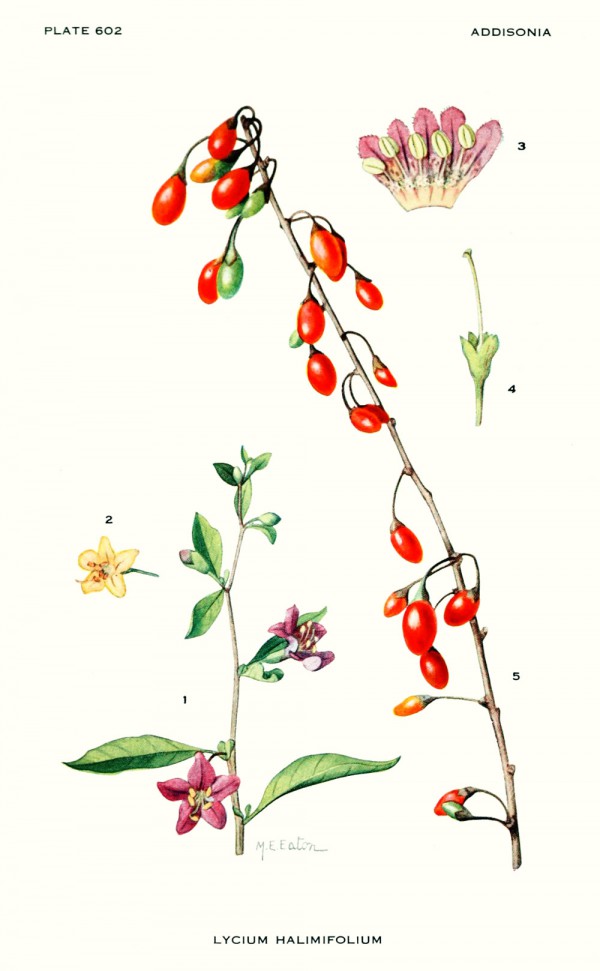Lycium barbarum L. - Solanaceae - 宁夏枸杞 ning xia gou qi (chin.), barbary matrimony vine, Duke of Argyll's tea tree, Tibetan goji, Himalayan goji, Chinese wolfberry, Chinese boxthorn, Gemeiner Bocksdorn, Gemeiner Teufelszwirn, Goji
Deciduus shrub or small tree (in cultivation), up to 2m tall, native to China, naturalized and cultivated elsewhere; branches thorny; leaves solitary or fasciculate, lanceolate (var. auranticarpum) or long elliptic (broad and papery, var. barbarum); inflorescences solitary or clustered flowers, corolla purple, funnelform, tube 8-10 mm, obviously longer than limb and lobesb; berry red (var. barbarum) or orange-yellow (var. auranticarpum), oblong or ovoid. http://www.efloras.org/florataxon.aspx?flora_id=2&taxon_id=200020536
Lycium barbarum var. barbarum (Lycium halimifolium Miller; L.lanceolatum Veillard; L.turbinatum Veillard; L.vulgare Dunal.):
„Widely cultivated for medicine in N and S China, especially in Ningxia and Tianjin Shi. The fruits are used medicinally as a tonic.“ http://www.efloras.org/florataxon.aspx?flora_id=2&taxon_id=210001170
„The Duke of Argyll introduced Lycium barbarum into the United Kingdom in the 1730s where it is known as Duke of Argyll's Tea Tree. It was and still is used for hedging, especially in coastal districts. Its red berries are attractive to a wide variety of British birds.“ https://en.wikipedia.org/wiki/Lycium_barbarum
The fresh or dried berries (of L.barbarum, 宁夏枸杞 ning xia gou qi or L.chinense, 枸杞 gou qi) are one of the most important traditional medicines in China, mainly used as general tonic to improve blood, strengthnen body, to protect liver (and kidney), and to improve eyesight. [Medicinal Plants of the World. Ben-Erik Van Wyk and Michael Wink, Pretoria 2004, 195]
The EU Register of nutrition and health claims made on foods stated that: „Contains antioxidant/s; Is a source of antioxdiant/s. With antioxidant/s. Contributes to the cell protection against free radicals Can protect your cells and tissues from oxidation Can contribute to the total antioxidant capacity of the body. Non-compliance with the Regulation because on the basis of the scientific evidence assessed, this claimed effect for this food has not been substantiated.“ http://ec.europa.eu/nuhclaims/
Goji berries are regarded as safe, but there are no data for risk groups (children, pregnant women) available. Hyoscyamine is not present or only in traces. According to Chinese textbooks, pregnant should not take Goji berries and it is also recommended that patients with diarrhea, fever, arthritis and severe inflammation should not consume goji berries.
[Bundesinstitut für Risikobewertung, Risikobewertung von Pflanzen und pflanzlichen Zubereitungen, Berlin 2012, 19-40] http://www.bfr.bund.de/cm/350/risikobewertung-von-pflanzen-und-pflanzlichen-zubereitungen.pdf
Goji might lower blood pressure and blood sugar. „The use of goji was first described in the first century AD in Chinese literature. Traditionally, goji has been used to promote longevity. Legend claims that one herbalist who used goji in combination with other tonic herbs lived 252 years…
Goji is used for diabetes, high blood pressure, poor circulation, fever, malaria, and cancer. It's also used for erectile dysfunction (ED), dizziness, ringing in the ears (tinnitus); and to reduce fever, sweating, irritability, thirst, nosebleeds, cough, and wheezing…
Taking goji by mouth during pregnancy is LIKELY UNSAFE. It contains a chemical, betaine, which could cause miscarriage. Don't use goji if you are pregnant or breast-feeding.“
[Lycium, MedlinePlus. US National Institutes of Health. January 2013] https://www.nlm.nih.gov/medlineplus/druginfo/natural/1025.html
„The combined results of the GC-O and OAV revealed that hexanal, (E)-2-hexenal, nonanal, isoamylol, 1-hexanol, 1-octen-3-ol, hexyl acetate, methyl salicylate, ethyl octanoate, o-cymene, d-limonene, linalool, β-cyclocitral, β-elemene and 2-pentylfuran were the characteristic aroma volatiles in the Ningxia goji berries. During fruit development, the content of hexyl acetate, linalool and 2-pentylfuran increased remarkably.“
[Lu, Juanfang, et al. „Identification of characteristic aroma volatiles of Ningxia goji berries (Lycium barbarum L.) and their developmental changes.“ International Journal of Food Properties just-accepted (2017)]

Lycium barbarum L. as Lycium halimifolium Miller, Addisonia, vol.18 t.602 (1933-1934) [M.E.Eaton]
http://plantgenera.org/species.php?id_species=626817
Lycium barbarum © Rolf Marschner (2018)
www.botanische-spaziergaenge.at
